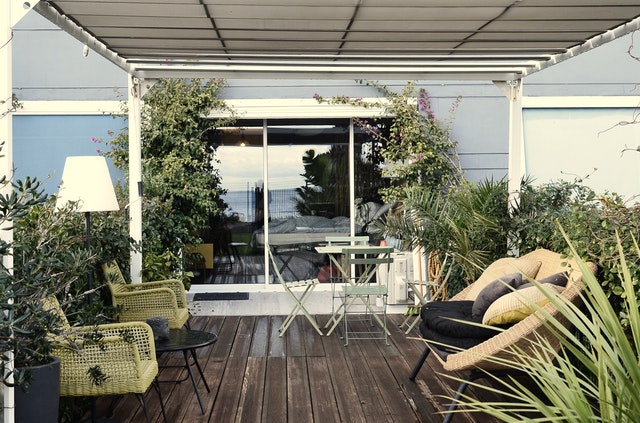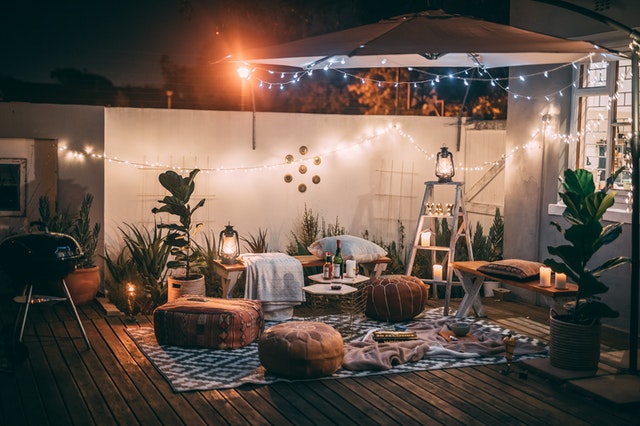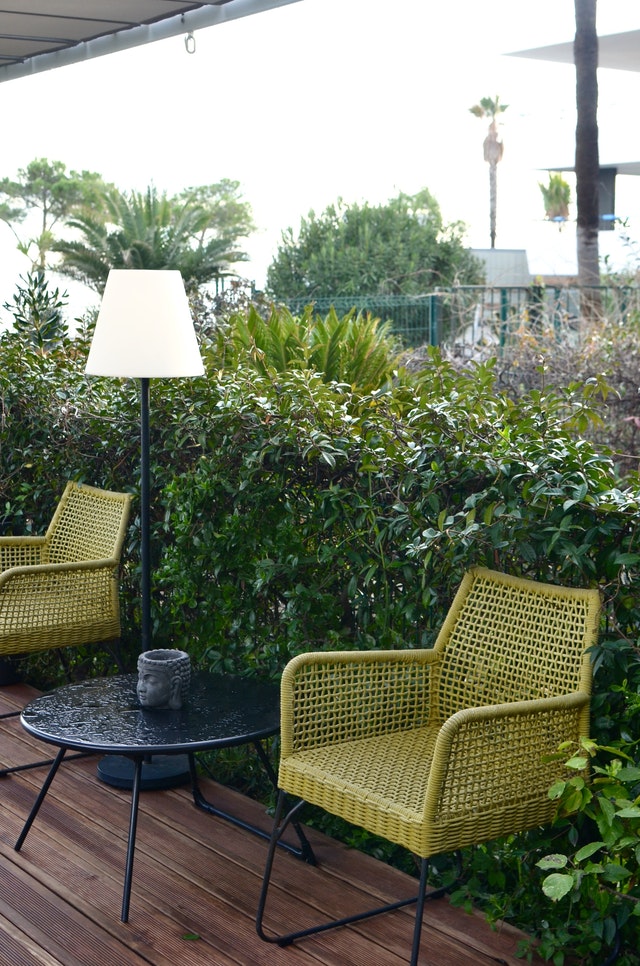Relaxing under cover-whether it’s an overgrown pergola or a quirky entertaining she-combines the best of domestic life, bringing the outdoors in and the indoors out. From country verandas to cool canopies, these fresh airy rooms create an easygoing space where we can cook and eat alfresco, take a nap in the sun, or enjoy the view sheltered from the weather but open to the elements.
Vintage gardenalia and secondhand pieces create the perfect mood for outdoor entertaining. School benches and industrial worktables provide instant seating for large groups, while a pair of church pews or antique benches will comfortably accommodate an intimate gathering. A throw, plump pillows, and a well-worn rug will soften any hard surfaces and add to the inside/out illusion. Create a cheerful, summery feel with mismatched wooden chairs painted in ice-cream pastels or off-whites, kitsch florals, and vintage bunting. Fill vintage pitchers and pails with bright blooms and foliage. Opt for a retro look with salvaged office chairs, aluminum tables, and 1960s fabric prints, or create vacation chic with bentwood café chairs, wirework benches, and striped fabrics. For a pared-down, recycled look, team distressed wooden benches and chairs with neutral fabrics-sackcloth, calico, unbleached cotton, or linen, decorations made from raw materials and objets trouves, such as candles, moss, river rocks, and driftwood, complete the look.
Entertaining
When it comes to dining en masse, salvaged furniture creates inexpensive, large-scale seating in a hurry. Village hall trestles, pool tables, or antique cast-iron fencing topped with glass- almost any flat surface can be repurposed into a welcoming dining table. For large numbers of people, look toward public or institutional furniture-canteen tables, refectory benches, hospital gurneys, and industrial work surfaces. Architectural sections of wood-large doors, cupboards, floorboards, shutters, and paneling-also transform into dining tabletops on a garden scale.
Create a casual, knee-height table surface with a reclaimed railway trolley, wooden palette, or a vintage door on blocks. Large wooden cable drums and office coffee tables look quirky dragged out of context and into the stress-free surroundings of a garden. Glass-topped bird tables, stools, washstands, blanket boxes, sewing tables, shoe racks, butcher’s blocks, and upturned creates all make quirky occasional tables for guests to place their glasses or plates. To add to the atmosphere, ceramic sinks, wheelbarrows, old coppers, oil drums, and laundry tubs filled with ice make instant drink coolers, while old glass bottles, jars, and decorative cans make charming and inexpensive flower or candle holders.
When you are creating your outdoor dining space, give a thought to protecting your guests from the elements. A simple recycled tarpaulin or sail strung between the trees provides instant makeshift cover from sun and light showers or, for something more substantial, consider an antique gazebo or vintage canvas sun shelter. An old summerhouse or tool shed can easily be converted into an outdoor dining room, ensuring the weather won’t ever spoil your fun. An overgrown trellis, arch, or gazebo will also provide a degree of protection- keeping the worst excesses of the midday sun from your guests. So many garden spaces focus on what’s at ground level-the joy of creating a covered dining space or relaxing area is that you can build a structure that takes the eye upward and outward, making the space feel more expansive and exciting.
The biggest challenge with outdoor entertaining is keeping guests cozy when the evening draws in-providing plenty of natural wool blankets, throws, thrift shop pillows, and bolsters will keep guests toasty and warm and more inclined to linger. Vintage lanterns and flares will add spots of warmth, but for a real blast of heat use an old wood-burning chiminea or fire pit.
For maximum visual effect, think about where you are going to set the stage of your alfresco meal. It’s tempting to plonk your table and chairs in the middle of the lawn but think of other spaces that might work better. A hidden corner of the garden or a meal among an orchard will create an intimate dining space-the plants and trees acting as walls and ceiling, perfect for hanging lanterns and tealights to brighten the dusk.
Push the chairs and tables right next to the house and rig up a canopy, and you create a street café vibe and have the added advantage of being close to the kitchen. The back wall of the house also makes the perfect backdrop for decoration, whether it’s fairy lights or a fabric screen. Or, if you’re lucky enough to have a large garden, create a dining space at the farthest point from the house. Part of the adventure of the evening will be picking your way down the garden path and eating a meal under the stars.





